
Chamaeleon is a small constellation in the deep southern sky. It is named after the chameleon, a kind of lizard. It was first defined in the 16th century.

A nebula is a distinct luminescent part of interstellar medium, which can consist of ionized, neutral, or molecular hydrogen and also cosmic dust. Nebulae are often star-forming regions, such as in the Pillars of Creation in the Eagle Nebula. In these regions, the formations of gas, dust, and other materials "clump" together to form denser regions, which attract further matter and eventually become dense enough to form stars. The remaining material is then thought to form planets and other planetary system objects.
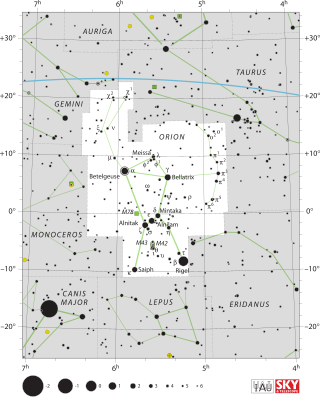
Orion is a prominent set of stars visible during winter in the northern celestial hemisphere. It is one of the 88 modern constellations; it was among the 48 constellations listed by the 2nd-century astronomer Ptolemy. It is named after a hunter in Greek mythology.

The Orion Nebula is a diffuse nebula situated in the Milky Way, being south of Orion's Belt in the constellation of Orion,[b] and is known as the middle "star" in the "sword" of Orion. It is one of the brightest nebulae and is visible to the naked eye in the night sky with an apparent magnitude of 4.0. It is 1,344 ± 20 light-years (412.1 ± 6.1 pc) away and is the closest region of massive star formation to Earth. The M42 nebula is estimated to be 24 light-years across. It has a mass of about 2,000 times that of the Sun. Older texts frequently refer to the Orion Nebula as the Great Nebula in Orion or the Great Orion Nebula.

A stellar association is a very loose star cluster, looser than both open clusters and globular clusters. Stellar associations will normally contain from 10 to 100 or more visible stars. An association is primarily identified by commonalities in its member stars' movement vectors, ages, and chemical compositions. These shared features indicate that the members share a common origin. Nevertheless, they have become gravitationally unbound, unlike star clusters, and the member stars will drift apart over millions of years, becoming a moving group as they scatter throughout their neighborhood within the galaxy.
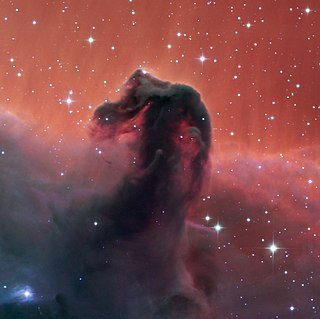
The Horsehead Nebula is a small dark nebula in the constellation Orion. The nebula is located just to the south of Alnitak, the easternmost star of Orion's Belt, and is part of the much larger Orion molecular cloud complex. It appears within the southern region of the dense dust cloud known as Lynds 1630, along the edge of the much larger, active star-forming H II region called IC 434.

IC 434 is a bright emission nebula in the equatorial constellation of Orion. It was discovered on February 1, 1786 by German-British astronomer William Herschel. The nebula is located at a distance of approximately 1,260 ly (385 pc) from the Sun and spans the interior of a neutral hydrogen shell with an angular size of 2° × 4°. At that distance, the dimensions correspond to a projected size of 42 ly × 85 ly.
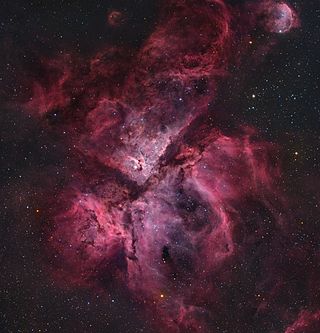
The Carina Nebula or Eta Carinae Nebula is a large, complex area of bright and dark nebulosity in the constellation Carina, located in the Carina–Sagittarius Arm of the Milky Way galaxy. The nebula is approximately 8,500 light-years (2,600 pc) from Earth.
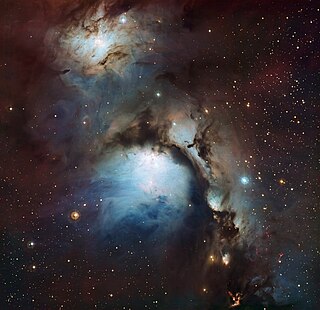
Messier 78 or M78, also known as NGC 2068, is a reflection nebula in the constellation Orion. It was discovered by Pierre Méchain in 1780 and included by Charles Messier in his catalog of comet-like objects that same year.

Eridanus is a constellation which stretches along the southern celestial hemisphere. It is represented as a river. One of the 48 constellations listed by the 2nd century AD astronomer Ptolemy, it remains one of the 88 modern constellations. It is the sixth largest of the modern constellations. The same name was later taken as a Latin name for the real Po River and also for the name of a minor river in Athens.

Barnard's Loop is an emission nebula in the constellation of Orion. It is part of the Orion molecular cloud complex which also contains the dark Horsehead and bright Orion nebulae. The loop takes the form of a large arc centered approximately on the Orion Nebula. The stars within the Orion Nebula are believed to be responsible for ionizing the loop.

The Orion molecular cloud complex is a star-forming region with stellar ages ranging up to 12 Myr. Two giant molecular clouds are a part of it, Orion A and Orion B. The stars currently forming within the complex are located within these clouds. A number of other somewhat older stars no longer associated with the molecular gas are also part of the complex, most notably the Orion's Belt, as well as the dispersed population north of it. Near the head of Orion there is also a population of young stars that is centered on Meissa. The complex is between 1 000 and 1 400 light-years away, and hundreds of light-years across.

Sh 2-279 is an HII region and bright nebulae that includes a reflection nebula located in the constellation Orion. It is the northernmost part of the asterism known as Orion's Sword, lying 0.6° north of the Orion Nebula. The reflection nebula embedded in Sh 2-279 is popularly known as the Running Man Nebula.

IC 443 is a galactic supernova remnant (SNR) in the constellation Gemini. On the plane of the sky, it is located near the star Eta Geminorum. Its distance is roughly 5,000 light years from Earth.

IC 5146 is a reflection/emission nebula and Caldwell object in the constellation Cygnus. The NGC description refers to IC 5146 as a cluster of 9.5 mag stars involved in a bright and dark nebula. The cluster is also known as Collinder 470. It shines at magnitude +10.0/+9.3/+7.2. Its celestial coordinates are RA 21h 53.5m, dec +47° 16′. It is located near the naked-eye star Pi Cygni, the open cluster NGC 7209 in Lacerta, and the bright open cluster M39. The cluster is about 4,000 ly away, and the central star that lights it formed about 100,000 years ago; the nebula is about 12 arcmins across, which is equivalent to a span of 15 light years.

IC 405 is an emission and reflection nebula in the constellation Auriga north of the celestial equator, surrounding the bluish, irregular variable star AE Aurigae. It shines at magnitude +6.0. Its celestial coordinates are RA 05h 16.2m dec +34° 28′. It is located near the emission nebula IC 410, the open clusters M38 and M36, and the K-class star Iota Aurigae.

HD 21389 is a supergiant variable star in reflection nebula VdB 15, in the constellation Camelopardalis. It has the variable star designation CE Camelopardalis, abbreviated CE Cam. This object is part of the Camelopardalis OB1 association. The near-identical member CS Camelopardalis lies half a degree to the north.

The Rho Ophiuchi cloud complex is a complex of interstellar clouds with different nebulae, particularly a dark nebula which is centered 1° south of the star ρ Ophiuchi, which it among others extends to, of the constellation Ophiuchus. At an estimated distance of about 140 parsecs, or 460 light years, it is one of the closest star-forming regions to the Solar System.
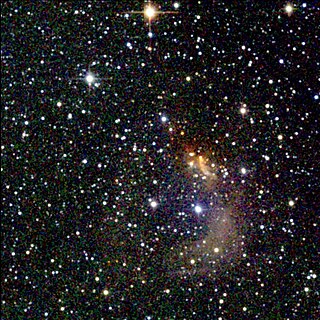
Vela Molecular Ridge is a molecular cloud complex in the constellations Vela and Puppis. Radio 12CO observations of the region showed the ridge to be composed of several clouds, each with masses 100,000–1,000,000 M☉. This cloud complex lies on the sky in the direction of the Gum Nebula (foreground) and the Carina–Sagittarius Spiral Arm (background). The most important clouds in the region are identified by the letters A, B, C and D, and in fact belong to two different complexes: the clouds A, C and D are located at an average distance of about 700-1000 parsecs and are related to the OB association Vela R2, while cloud B is located at a greater distance, up to 2000 parsecs away, and is physically connected to the extended Vela OB1 association.



















